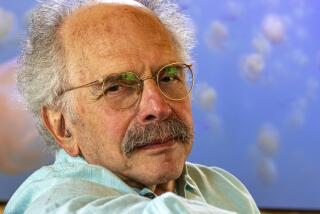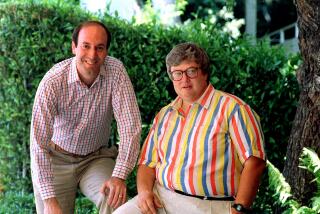When His Thumb Turned, Millions Got the Message
- Share via
Roger Ebert and the late Gene Siskel weren’t the first movie critics on television: People like NBC’s Gene Shalit and Joel Siegel of ABC were at it long before they were.
But when Siskel and Ebert’s syndicated movie review program took off and their “thumbs up, thumbs down” judgments were embraced by moviegoers, they became the most powerful, and they inadvertently created a potent marketing tool for the movie studios.
“It became the Good Housekeeping Seal of Approval for movies,” said 20th Century Fox senior executive Tom Sherak.
Siskel, who died Saturday at age 53, was without question a powerful man in Hollywood, though perhaps not a strong presence among film critics.
Part of Siskel and Ebert’s power was a matter of exquisite timing. Their arrival on the national scene with a weekly syndicated TV movie review show in the late ‘70s coincided with the major studios’ practice of releasing movies “wide,” or in thousands of theaters around the country on the same day, supported by heavy television advertising.
“It was always a major plus to get their approval,” said Sony Pictures distribution head Jeff Blake. “I can’t think of a case where we got two thumbs up that we didn’t use it [in TV ad spots].”
Over the years, studio marketing departments often inflated Siskel and Ebert’s “thumbs,” sometimes shamelessly. “ ‘Two thumbs up’ became ‘Two thumbs way up,’ ” Chris Pula, Disney marketing chief, said with a laugh, “the same way as we run ads with ‘the No. 1 thriller in America.’ ”
In terms of direct box-office impact, Siskel and Ebert have had the greatest influence in their home market of Chicago, where Siskel was the critic and later columnist for the Chicago Tribune and Ebert remains the critic for the Chicago Sun-Times. Blake said a “two thumbs down” or “two thumbs up” judgment had a direct impact on opening weekend grosses in Chicago, the third-largest movie market in the country.
Outside of Chicago, their reviews became an important part of the national mix, alongside the major East and West Coast newspaper critics and national newsmagazine reviewers. When they got behind a movie in a big way, they could change the movie’s profile nationally.
After so-so reviews for Billy Bob Thornton’s “Sling Blade” when it played at the 1996 New York Film Festival, Marci Granata, a marketing executive at Miramax, said, Siskel and Ebert’s enthusiasm for the film led the way for more widespread acceptance. Siskel, a major basketball fan, was a strong supporter of the 1994 documentary “Hoop Dreams” and is credited with helping that film achieve high visibility and very strong business for a nonfiction feature.
Ebert and Siskel’s shows mixed big studio films with American independent movies and even foreign films, which became a vital tool for smaller film distributors who didn’t have the money to widely advertise their films on television. Having a “Sling Blade” or a foreign film such as “Life Is Beautiful” reviewed alongside major studio movies gave those films added weight.
“They also came back and re-reviewed movies when they reached home video, especially movies they felt had been neglected,” DreamWorks marking head Terry Press said.
Siskel and Ebert helped legitimize TV reviewers, Press said. “The people who owe Gene and Roger the greatest debt of gratitude were other TV critics. Their power is a direct result of Siskel and Ebert. Their credibility as critics eventually extended to other TV reviewers.”
But unlike most TV pundits, Siskel and Ebert brought a depth and knowledge of movies to their broadcasts. Their enthusiasm for movies was palpable, and even after their show became a major success and was bought by the Walt Disney Co., “they bashed Disney movies with the best of them,” recalled Press, who formerly headed marketing and PR at Disney.
Their Midwest base also set them apart from other TV reviewers. Neither came from the two major media capitals, and studio marketing executives believe they reflected a general audience sensibility.
“Gene and Roger embodied what went on at the water cooler in offices every Monday morning,” Granata said. “The great thing was that they often didn’t agree with each other. But they were so smart in how they argued. They did it on a level that other people understood. Gene, in particular, projected himself as the average guy, so you believed in what he was saying.”
“They were neither East Coast snobs nor pawns of the West Coast Hollywood system, and that endeared them to their audience,” Pula said. “It was like an evening with George and Martha or Archie and Edith Bunker.”
It is unclear what form the syndicated “Siskel and Ebert” will take. A spokesman said that plans were in limbo.
“It’ll be interesting to see if the show’s influence can continue without Gene,” Press said. “Their success came from their friction. They knew how to drive each other crazy like an old married couple. And that’s what made the show so watchable.”
More to Read
The biggest entertainment stories
Get our big stories about Hollywood, film, television, music, arts, culture and more right in your inbox as soon as they publish.
You may occasionally receive promotional content from the Los Angeles Times.










